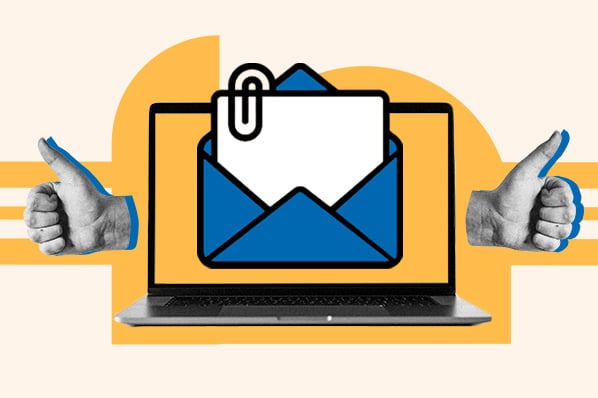Standing out from the crowd is never easy, especially when you’re trying to differentiate your email from the tens or hundreds of other unread ones in your prospect’s inbox.
One of the most effective ways to catch their attention? Create a sense of intrigue. The buyer will satisfy their curiosity by clicking on your email.
Assuming you’ve written a personalized, relevant message, you’ll likely earn their response.
To discover the best ways to create intrigue, I looked through every sales email I’ve opened in the past few months. Here are four common strategies.
1) Make It Personal
At the end of the day, nothing sparks curiosity like a personal touch. As Dale Carnegie once said, “A person’s name, to that person, is the sweetest, most important sound in any language.”
In other words, your prospect will respond to personalized content.
That doesn’t mean simply inserting their name and/or their company’s name into the subject line. Most buyers have seen this trick again and again, and it’s lost its impact.
I define “personalized” as unique to that individual. Any subject line that you could use for two or more different prospects isn’t personalized.
Mention someone’s latest blog post, a detail from their LinkedIn profile, an event they recently attended, a statistic from their organization -- any piece of information that’s both relevant to your product and distinct to the prospect.
Here are several examples:
- “Impressed to learn 46% of your engineers are self-taught”
- “How did your Partner Field Day go?”
- “counterpoint to your ‘radical candor’ article”
- “Saw you won a Charlie award”
- “Did you make it to Tim Urban’s INBOUND talk?”
2) Create Suspense
TV producers are masters at creating suspense. They present a tense or shocking moment, raise your desire to know what happens next to peak levels -- then cut to a commercial break. And they do this three to seven times per episode.
Luckily, salespeople only have to pull off this feat once. Do so by revealing some information, but not everything your prospect would want to know.
For instance, you might write, “Analyzed your company’s two-year hiring trends -- surprising results”.
Who wouldn’t be compelled to open the email and discover what was unique about their organization’s hiring trends?
Here are five more examples:
- “Liked your [topic] blog post … But something was missing” (In your email, suggest a tip, additional point, or idea for a follow-up post.)
- “This isn’t your typical sales email” (Make sure the contents lives up to this promise.)
- “If I could change one thing about [prospect’s company] … ” (Deliver a relevant insight or piece of advice.)
- “We have X things in common” (This one is ideal for prospects with whom you have multiple commonalities. Quickly list those commonalities in your email: “We both went to [school], have boisterous puppies, and require water for survival.”)
- “In five years, I think [company] … ” (Tie this into your intro. If you see an opportunity the prospect’s company isn’t capitalizing on or an area where they’re struggling, portray what the future will look like without a change.)
3) Call Out a Specific Challenge
Customers don’t want to buy products -- they want to solve their problems. To arouse a prospect’s interest, highlight an issue they’re currently dealing with. Anticipate their business pain before you’ve spoken directly to them by comparing their organization to similar ones you’ve sold to. What pain points do those companies typically deal with?
For example, maybe four of the five manufacturing firms that have purchased your product struggle with workforce shortages.
With that in mind, you might use this subject line for a prospect at a manufacturing firm: “Hiring and retention issues at [company]?”
Perhaps your marketing automation software indicates the prospect has visited the same blog post on your website multiple times or downloaded an ebook. There’s a strong chance they’re focused on the topic of that piece of content. A good subject line would be, “Idea for solving [company’s] workforce shortage.”
Social media is also a great resource. Prospects will frequently post questions related to a challenge, strategic announcements and updates, and other potentially valuable tidbits.
An example subject line: “Re: the talent shortage ebook you shared”.
4) Don’t Repeat Your Subject Line
People typically use three details to decide whether to open a message. First, they look at the sender. Is the name familiar?
Next, they read the subject line. Finally, they look at the first few words of the email.
As a salesperson, your name -- maybe even your company -- will be foreign to prospects. That means you’re solely relying on the subject line and opening sentence.
If you simply repeat the subject line, you’ll waste valuable space. Instead, use your intro to build on it.
Here’s a before-and-after example to illustrate:
Subject line: “Is [prospect’s company] struggling with [relevant challenge]?”
Preview text: “Hi [prospect name], Is [prospect’s company] having issues with X?”
Subject line: “Issues with X at [prospect’s company]”
Preview text: “Hi [prospect name], 76% of businesses in your space are dealing with … ”
The latter makes the buyer eager to learn more. It also communicates more information in the same amount of space, which is critical when you’re dealing with limited attention spans.
Buyers are busier than ever, which is why many salespeople say prospecting is their biggest challenge. Use these four techniques to break through the noise and get your prospects’ attention.






![How to Introduce Yourself in an Email in [Almost] Every Situation](https://www.hubspot.com/hubfs/how-to-introduce-yourself-over-email-1.jpg)


![23 Sales Email Templates With 60% or Higher Open Rates [+ Bonus Templates]](https://www.hubspot.com/hubfs/sales-email-templates-2.jpg)


